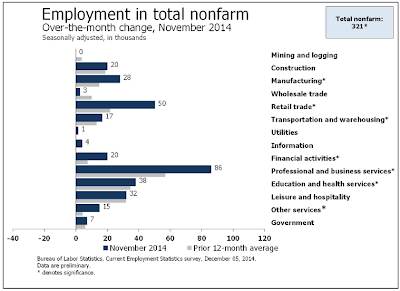Initial Reaction
The payroll survey shows a net gain of 321,000 jobs vs. a Bloomberg consensus expectation of 230,000 jobs. September was revised up from 256,000 to 271,000. October was revised up from 214,000 to 243,000.
The unemployment rate was steady although employment only rose by 4,000 in the household survey. Unemployment actually rose by 115,000. Swings in household survey employment and the labor force have been wild lately.
Once again we are in a situation where the establishment survey and the household survey are at odds. Over time these fluctuations tend to smooth out. The question, as always, is “in whcih direction”.
BLS Jobs Statistics at a Glance
- Nonfarm Payroll: +321,000 – Establishment Survey
- Employment: +4,000 – Household Survey
- Unemployment: +115,000 – Household Survey
- Involuntary Part-Time Work: -177,000 – Household Survey
- Voluntary Part-Time Work: +235,000 – Household Survey
- Baseline Unemployment Rate: +0.0 at 5.8% – Household Survey
- U-6 unemployment: -0.1 to 11.4% – Household Survey
- Civilian Non-institutional Population: +187,000
- Civilian Labor Force: +119,000 – Household Survey
- Not in Labor Force: +69,000 – Household Survey
- Participation Rate: +0.0 at 62.8 – Household Survey
November 2014 Employment Report
Please consider the Bureau of Labor Statistics (BLS) November 2014 Employment Report.
Total nonfarm payroll employment increased by 321,000 in November, and the unemployment rate was unchanged at 5.8 percent, the U.S. Bureau of Labor Statistics reported today. Job gains were widespread, led by growth in professional and business services, retail trade, health care, and manufacturing.
Click on Any Chart in this Report to See a Sharper Image
Unemployment Rate – Seasonally Adjusted
Nonfarm Employment January 2011 – November 2014
Nonfarm Employment Change from Previous Month by Job Type
Hours and Wages
Average weekly hours of all private employees rose by 0.1 hours to 34.6 hours. For three consecutive months I said the exact same thing. Twice in a row, a correction now put the previous month at 34.5 hours. Average weekly hours of all private service-providing employees was flat at 33.4 hours.
Average hourly earnings of production and non-supervisory private workers rose $0.04 to $20.74. Average hourly earnings of production and non-supervisory private service-providing employees also rose $0.04 to $20.53.
For discussion of income distribution, please see What’s “Really” Behind Gross Inequalities In Income Distribution?
Birth Death Model
Starting January 2014, I dropped the Birth/Death Model charts from this report. For those who follow the numbers, I retain this caution: Do not subtract the reported Birth-Death number from the reported headline number. That approach is statistically invalid. Should anything interesting arise in the Birth/Death numbers, I will add the charts back.
Table 15 BLS Alternate Measures of Unemployment
click on chart for sharper image
Table A-15 is where one can find a better approximation of what the unemployment rate really is.
Notice I said “better” approximation not to be confused with “good” approximation.
The official unemployment rate is 5.8%. However, if you start counting all the people who want a job but gave up, all the people with part-time jobs that want a full-time job, all the people who dropped off the unemployment rolls because their unemployment benefits ran out, etc., you get a closer picture of what the unemployment rate is. That number is in the last row labeled U-6.
U-6 is much higher at 11.4%. Both numbers would be way higher still, were it not for millions dropping out of the labor force over the past few years.
Mike “Mish” Shedlock
http://globaleconomicanalysis.blogspot.com



